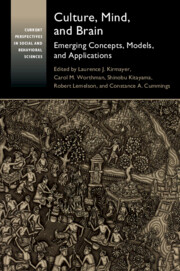Book contents
- Culture, Mind, and Brain
- Current Perspectives in Social and Behavioral Sciences
- Culture, Mind, and Brain
- Copyright page
- Dedication
- Epigraph
- Contents
- Figures
- Tables
- Contributors
- Preface
- Abbreviations
- 1 Introduction
- Part I Dynamics of Culture, Mind, and Brain
- Part II Applications
- 12 The Cultural Brain as Historical Artifact
- 13 Experience-Dependent Plasticity in the Hippocampus
- 14 Liminal Brains in Uncertain Futures
- 15 The Reward of Musical Emotions and Expectations
- 16 Literary Analysis and Weak Theories
- 17 Capturing Context Is Not Enough
- 18 Social Neuroscience in Global Mental Health
- 19 Cities, Psychosis, and Social Defeat
- 20 Internet Sociality
- 21 Neurodiversity as a Conceptual Lens and Topic of Cross-Cultural Study
- 22 Epilogue
- Index
- References
14 - Liminal Brains in Uncertain Futures
Critical Neuroscience and the Cultural Contexts of Neuroeducation
from Part II - Applications
Published online by Cambridge University Press: 18 September 2020
- Culture, Mind, and Brain
- Current Perspectives in Social and Behavioral Sciences
- Culture, Mind, and Brain
- Copyright page
- Dedication
- Epigraph
- Contents
- Figures
- Tables
- Contributors
- Preface
- Abbreviations
- 1 Introduction
- Part I Dynamics of Culture, Mind, and Brain
- Part II Applications
- 12 The Cultural Brain as Historical Artifact
- 13 Experience-Dependent Plasticity in the Hippocampus
- 14 Liminal Brains in Uncertain Futures
- 15 The Reward of Musical Emotions and Expectations
- 16 Literary Analysis and Weak Theories
- 17 Capturing Context Is Not Enough
- 18 Social Neuroscience in Global Mental Health
- 19 Cities, Psychosis, and Social Defeat
- 20 Internet Sociality
- 21 Neurodiversity as a Conceptual Lens and Topic of Cross-Cultural Study
- 22 Epilogue
- Index
- References
Summary
The neuroimaging era has brought an increasingly refined understanding of adolescent brain maturation, yielding insight into the protracted development of social cognition, learning, and executive function beyond childhood. These data have been applied in multiple domains of everyday life, including education. Adolescent brains have emerged as a theater of moral panic over the implications of social media on the one hand and income inequality on the other for mental health, social cohesion, and individual and community life chances. In this setting, neuroscience has been invoked to account for adolescent vulnerability and to develop interventions to mitigate behavioral problems and mental illness. These include the introduction into school curricula of mindfulness-based stress reduction, resilience training, “brain-based” pedagogy, and a neuroanatomical lexicon of introspection in which kids are encouraged to identify experiential states with brain regions. “Neuroeducation” represents a constellation of fluid alliances between the education profession, Silicon Valley tech solutionists, and the human potential movement. Cognitive neuroscience plays a notional role, chiefly via proponents’ invocation of developmental plasticity as physiological justification for interventions that are often based on preliminary research and remain wanting in clinical support. In this essay we explore neuroeducation through the lens of critical neuroscience.
- Type
- Chapter
- Information
- Culture, Mind, and BrainEmerging Concepts, Models, and Applications, pp. 389 - 401Publisher: Cambridge University PressPrint publication year: 2020



